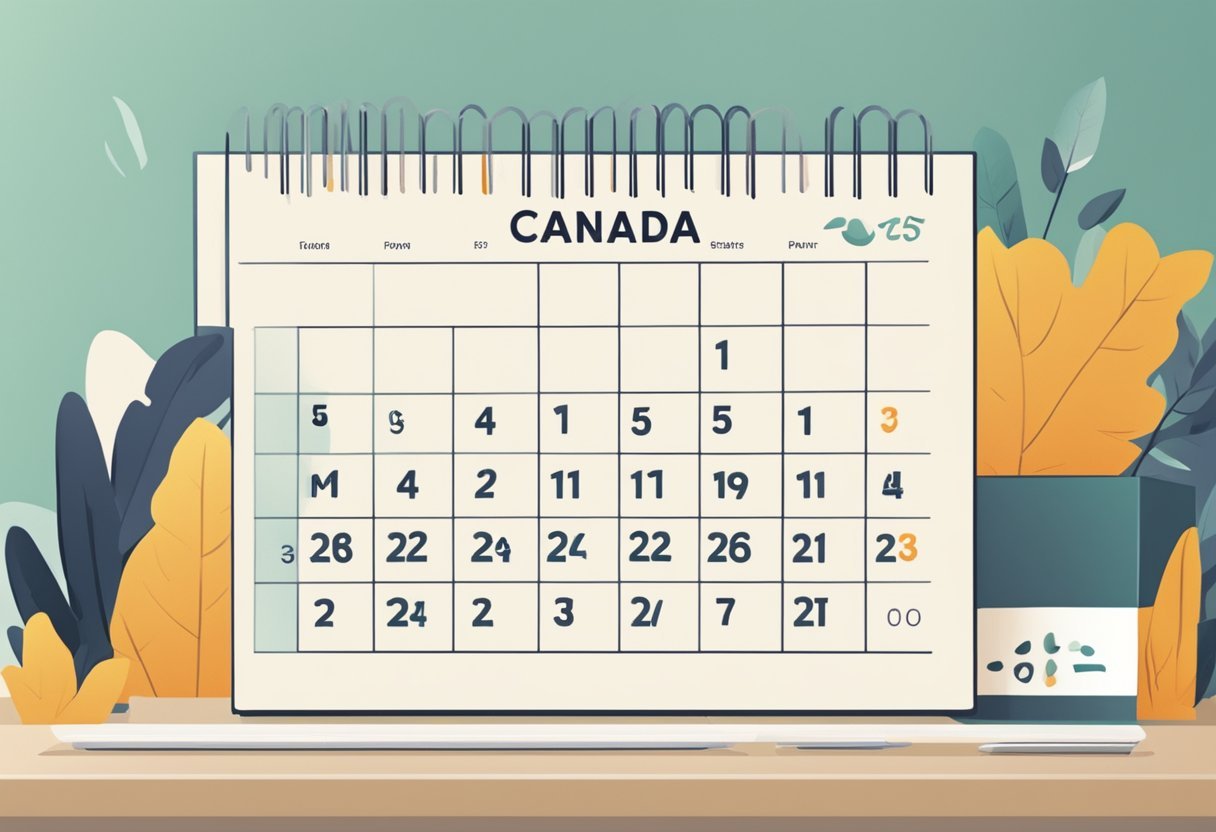Canada Benefits Payment Dates – Key Timelines and Schedules for 2025
Managing the financial aspects of life in Canada is crucial, and understanding the payment dates for government benefits is vital.
The Government of Canada issues various benefits to eligible individuals, including retirement pensions, child benefits, and income support. Knowing when these payments are disbursed can help you plan your budget effectively and ensure financial stability.

Receiving these benefits on time hinges on meeting eligibility requirements and completing the application process correctly. Canadian residents often rely on these benefits for their day-to-day expenses, long-term savings, or unexpected needs.
Familiarising yourself with the Canadian Revenue Agency’s schedule for benefit payments can alleviate stress and aid in personal financial management.
Canada Benefits Payment Dates – Key Takeaways
- The government issues benefit payments in Canadá following a regular schedule.
- Eligibility and timely application are essential to ensure consistent benefit payments.
- Understanding benefit types and payment schedules contributes to effective financial planning.
Elegibilidade e inscrição

Before you apply for Canadian benefits, you must understand the specific eligibility criteria and the application process to ensure you receive your first payment without delay. The Canada Revenue Agency (CRA) manages various benefit programs, and each may have different requirements based on family composition, age, and other factors.
General Eligibility for Canadian Benefits
- Family Composition: Your family size and composition are crucial in determining eligibility for benefits like the Canada Child Benefit (CCB).
- Age: Some benefits have age requirements, such as Old Age Security (OAS), and these age-related criteria must be met before applying.
- Residence: Applicants typically need to be Canadian residents and must meet the residency requirements outlined by the CRA.
- Renda: Most benefits are income-tested, so your annual earnings may affect your eligibility.
Applying for Benefits Online
- First-Time Applicants: If you’re applying for Canadian benefits for the first time, visit the CRA’s benefits page to start your application online.
- Existing Beneficiaries: For current recipients looking to update information or reapply, use the CRA My Account for a streamlined process.
- Support Documents: Be prepared with necessary documentation, such as identification and income statements, to avoid delays in benefit reception.
Before applying, check if you meet the eligibility criteria for each benefit programme. The timing of your first payment will vary based on when your application is processed and approved by the Canada Revenue Agency. Applying online is a convenient way to manage your benefits and ensure you receive them promptly.
Types of Benefits
As you navigate the various government benefits in Canada, it’s essential to understand which programs you might be eligible for. This section overviews crucial benefit schemes, including retirement support, child and family assistance, and disability and veteran provisions.
Canada Pension Plan and Old Age Security
- Canada Pension Plan (CPP): Paid monthly to eligible pensioners starting as early as age 60, the CPP is designed to replace a portion of your income upon retirement.
- Old Age Security (OAS): A monthly payment available to seniors aged 65 and older, OAS is one of Canada’s most extensive pension programs, providing a basic income to those who qualify regardless of work history.
Canada Child Benefit and Family Support
- Canada Child Benefit (CCB): A tax-free monthly payment to assist families with the cost of raising children under 18 years of age, the CCB improves financial accessibility for childcare.
- Alberta Child and Family Benefit (ACFB): Relevant for residents of Alberta, this benefit combines and replaces previous provincial programs, offering financial support to families with children.
Disability and Veteran Benefits
- Disability Benefits: These are meant to support individuals unable to work due to a disability, providing necessary financial assistance.
- Veteran Disability Pension: Aims to compensate veterans with an injury or illness attributable to their service, ensuring they receive the support they deserve.
Each benefit program has specific eligibility criteria and application procedures, which can be accessed through their respective benefits payment dates and more detailed information on the government’s benefits page.
Benefits Payment Schedule
Various benefits, such as the Canada Workers Benefit and the Alberta Child and Family Benefit Payment, operate on specific timelines in Canada. Knowing these dates helps to ensure you receive your payments without any unexpected delays.
Monthly Payment Timelines
Canada Workers Benefit: Advanced payments of this benefit are issued quarterly, but here are vital monthly dates for most federal benefits:
- October 2023: Payments will be made on the 27th.
- November 2023: Expect payments on the 28th.
- December 2023: The final benefits of the year are scheduled for the 20th.
Annual and Quarterly Benefits
Advanced Canada Workers Benefit: Payments are made to eligible individuals to provide financial support throughout the year. Here are the forthcoming dates:
- Janeiro de 2024: The first payment of the year will be on the 27th.
- June 2024: Mid-year payment expected on the 26th.
Climate Action Incentive Payment: Distributed quarterly to residents of eligible provinces to offset carbon taxes.
Ontario Trillium Benefit and Alberta Child and Family Benefit Payment: These are paid monthly to support families and individuals.
Tax Implications and Credits
Tax implications and credits are vital to navigating Canada’s tax system, directly impacting your net income. Understanding them ensures you’re well-informed about potential refunds or obligations.
Income Tax and Benefits
- Income Tax: Your net income is subject to federal and provincial taxes. The amount of tax you pay affects the benefits you may receive, such as the Canada Child Benefit (CCB). It’s important to consider how your taxable income interacts with the benefit payments you’re entitled to receive.
- Benefícios: Some benefits are tax-free, while others must be included in your net income for tax purposes. You should regularly check for updates on benefit payment dates to manage your finances effectively.
Goods and Services Tax Credits
- This credit is a quarterly payment that helps individuals and families with low and modest incomes offset all or part of the GST or HST they pay. If you’re eligible, you will receive it even if you have not paid taxes that year.
Provincial and Territorial Credits
- Ontario Sales Tax Credit (OSTC): Designed to help cover your sales tax, it’s paid monthly as part of the Ontario Trillium Benefit (OTB).
- Northern Ontario Energy Credit (NOEC): Aimed at helping residents of Northern Ontario with the higher energy costs they face, also part of the OTB.
- Ontario Energy and Property Tax Credit (OEPTC): This credit helps with the sales tax you pay and property taxes and is another component of the OTB.
Remember to keep track of these credits and understand how they relate to your taxes and benefits. Staying informed ensures you receive all the help you’re eligible for and optimises your net income.
Managing Benefits and Direct Deposit
Ensuring your benefit payments arrive punctually depends on updating your banking information with the Canada Revenue Agency (CRA). Opt for direct deposit to receive financial support seamlessly.
Updating Banking Information
Direct deposit is a reliable way to receive your payments without delay. Here’s how you can update your banking information:
- Online: Use the CRA’s My Account service to update your details securely.
- By Phone: Call the CRA and have your information ready to provide to an agent.
- Through Your Bank: Some financial institutions allow you to update your direct deposit information for CRA payments.
Remember, promptly updating your details ensures continuous support without interruption.
Using My Account Service
My Account by the Canada Revenue Agency is your hub for managing financial support services. Benefits of this service include:
- Tracking Payments: Review your payment history, including dates and amounts.
- Updating Personal Details: Easily change your address or marital status.
- Financial Tools: Access calculators and other tools to understand your benefits better.
With My Account, you control your benefits and personal data in one place.
Considerações Especiais
When navigating Canada’s benefits payment landscape, specific conditions apply to varying regional schemes and individual circumstances. You must know these nuances to understand and fully capitalise on the benefits available.
Benefits for Specific Provinces and Territories
Each province and territory in Canada may offer additional benefits on top of federal programs. For instance:
- Alberta has the Alberta Child and Family Benefit (ACFB), which provides direct financial support to lower-income families.
- Although their specific dates and criteria may vary, Manitoba and Saskatchewan provide provincial programs that augment national benefits.
Advance Payments and Retroactive Entitlement
Understanding payment timelines is essential:
- Advance Payments: For benefits like the enhanced Canada Workers Benefit, eligible recipients may receive funds in advance, helping to alleviate immediate financial pressures.
- Retroactive Entitlement: In some instances, if you’re eligible for a benefit but have not received it, it’s possible to receive a retroactive payment dating back to the entitlement period.
Support for Singles and Single Parents
Special consideration is given to individuals and single parents when assessing benefit entitlements:
- Se você é um single parent, you might be eligible for additional support through increased benefit amounts.
- Provinces like Columbia Britânica offer targeted support for single individuals, recognising their unique financial challenges.






